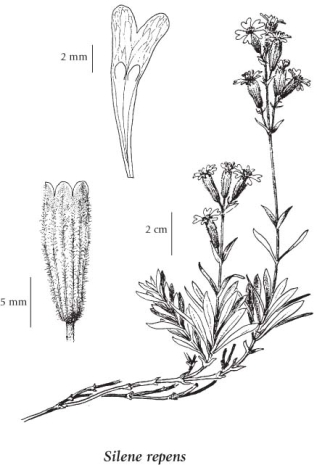Silene repens Patrin ex Pers.
pink campion
Caryophyllaceae (Pink family)
Introduction to Vascular Plants
pink campion
Caryophyllaceae (Pink family)
Introduction to Vascular Plants
Species Information
General:
Perennial from a branched stem-base and a short rhizome; tufted, often matted; stems erect, several, simple or branched, densely crinkled-hairy, 7-35 cm tall.
Leaves:
Basal leaves linear to narrowly lanceolate, 2-6 cm long, 2-6 mm wide, mostly deciduous by flowering time; stem leaves opposite, 2-6 pairs, about the same size as the basal leaves, slightly hairy; stipules lacking.
Flowers:
Inflorescence of usually 2-15 flowers in a contracted cluster; petals 5, white to pink or occasionally purple, stalklike at the bases, the blades 3-7 mm long, 2-lobed, the stalks 5-8 mm long; sepals white to usually pink or purple, united, forming a tube 10-15 mm long, 10-nerved, hairy and more or less glandular.
Fruits:
Capsules 10-14 mm long, 3- (4)-valved; seeds brown, 0.8-1.1 mm long, roughened.
Illustration

If more than one illustration is available for a species (e.g., separate illustrations were provided for two subspecies) then links to the separate images will be provided below. Note that individual subspecies or varietal illustrations are not always available.
Illustration Source: The Illustrated Flora of British Columbia
Ecology
Ecological Framework for Silene repens
The table below shows the species-specific information calculated from
original data (BEC database) provided by the BC Ministry of Forests and Range.
(Updated August, 2013)
The table below shows the species-specific information calculated from
original data (BEC database) provided by the BC Ministry of Forests and Range.
(Updated August, 2013)
| Site Information |
Value / Class |
||
|
Avg |
Min |
Max |
|
| Elevation
(metres) |
958 | 657 | 1200 |
| Slope
Gradient (%) |
46 | 40 | 65 |
|
Aspect (degrees) |
127 | 90 | 250 |
| Soil
Moisture Regime (SMR) [0 - very xeric; 4 - mesic; 8 - hydric] |
1 | 1 | 2 |
| Modal
Nutrient Regime
Class |
B | ||
| #
of field plots species was recorded in: |
4 | ||
| Modal
BEC Zone Class |
IDF | ||
|
All BEC Zones (# of stations/zone) species was recorded in |
IDF(2), SWB(2) | ||
|
Source:
Klinkenberg 2013
|
|||